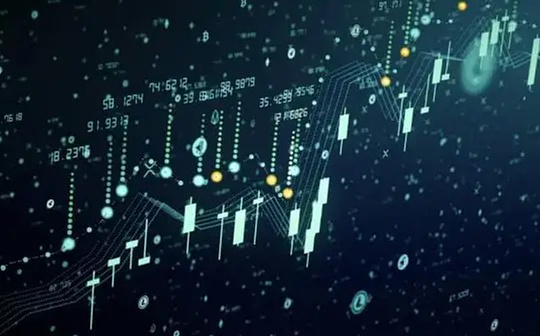Cookies.fun User Guide: How to find the AI Agent "Golden Dog" project?

Reprinted from panewslab
01/13/2025·29days agoOriginal title: "Dropping $7.5k to source high quality alpha"
Written by: yb effect, on-chain strategy analyst
Compiled by: zhouzhou, BlockBeats
Editor's note: This article describes how yb effect uses the Cookies.fun tool to improve his research efficiency in the field of cryptocurrency and AI agents. Although he spends a lot of time researching every day, he often misses important trends, so how to track the market more intelligently. Dynamics, analyzing agency projects, tracking KOL mentions and token holders can help you discover emerging projects and trends and improve the efficiency of information acquisition.
The following is the original content (the original content has been edited for ease of reading and understanding):
Analysis of user thinking, intelligent interactions and agent metagame via cookies I have never considered myself a trader, in fact I probably never will be.
Therefore, I never mess with complicated "tools", I don't have price alerts, I don't spend time on products like "Bloomberg Terminal", and I definitely don't touch leverage or perpetual contracts.
As you all probably know by now, my style is to pick a few projects or trends that interest me and then spend a lot of time digging into the details. This is why I can continue to produce two in-depth analyzes of more than 3,000 words per week. I will admit, though, that I do struggle to keep up with all the developments in the cryptoxAI space, which is part of my job.
Every day I wake up and discover something new that shocks me I didn’t know existed. I’m not saying I need to burn myself out by knowing every single project (most of it is bullshit anyway). But I do feel that I'm still missing out on some very important developments so far.
Let me ask you a question: If I spend 10+ hours a day researching these topics and closely following crypto Twitter, why do I still feel like I’m not keeping up and missing out on so many new narratives? I think the answer lies in my inefficient input of information. I was trying hard but didn't have a smart enough strategy for keeping up.
It’s one thing to do good research and write well (I think I’m pretty good at that). But another part of the job is knowing what topics to study and when to study them. With that in mind, let’s talk about how I would improve access to items, trends, narratives, and more. To be clear, this isn't something I'm going to spend a ton of time on, but rather hopefully establishing a routine of just 10 minutes every morning with my coffee so I know what crypto Twitter is paying attention to.
First, I'll focus on using cookiedotfun. To be clear, this is not an advertising post, I just feel like I can keep up better by carefully integrating cookies into my workflow.
This morning, I decided to spend about 7,500 to buy 10,000 Cookie Tokens to unlock premium features.

seize the moment
I've been really impressed by the Cookies.fun team over the past few months.
When Goat launched in October, the team immediately realized that the agency space would become the main narrative of this bull market.
So they decided to go all out to build the best analytics and data platform for AI agents.
Although there are other tools, such as aiagenttoolkit, kaito (not limited to agents), etc., I think that for most people's needs, Cookies is undoubtedly the best choice at the moment.
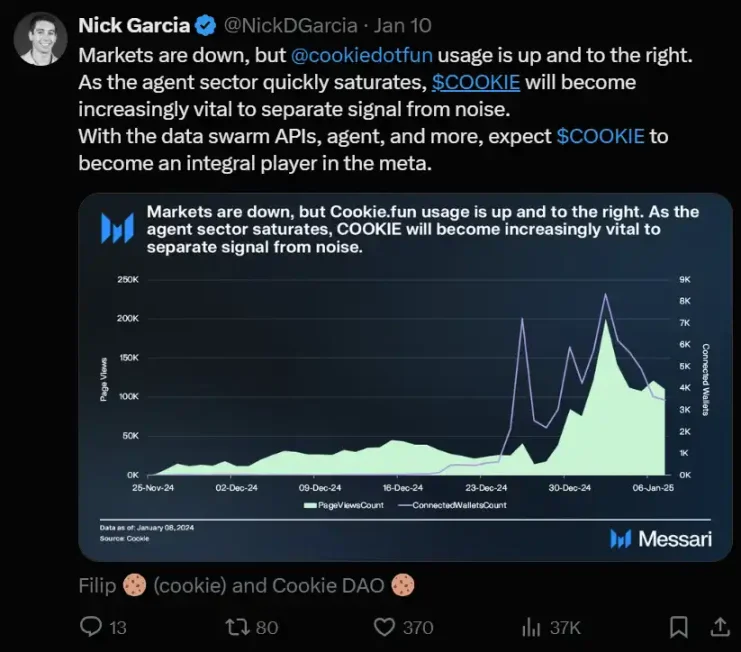
I had the opportunity to chat with the founders of Cookies.fun last December to hear them talk about their plans for the coming months and how to keep the product as crypto-native as possible (e.g. token gating features, in-depth crypto Twitter analysis, etc.) I'm impressed.
A brief overview of the tool:
Track more than 1,000 agents: including their popularity on crypto Twitter, social media interactions, market value versus influence, and more.
The team is indexing on-chain data and social media data to comprehensively analyze the dynamics of the field from both qualitative and quantitative perspectives.

The basic functionality is open to everyone and can be explored by anyone on the site. You need to hold 10,000 COOKIES to unlock advanced features. The market value of COOKIE tokens is currently between 150 million and 200 million US dollars, and the Binance perpetual contract has just been launched today.
In addition, it provides a rich API for integration with other projects. For example, Virtuals integrates the "Thought Heat" feature into its interface.
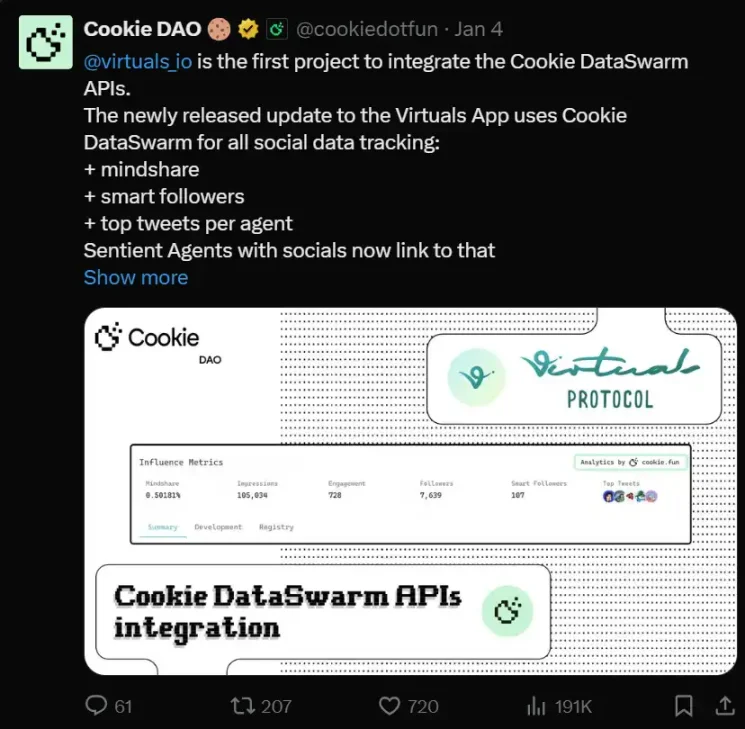
free features
This section provides an overview of the agency landscape: number of agents and market capitalization.
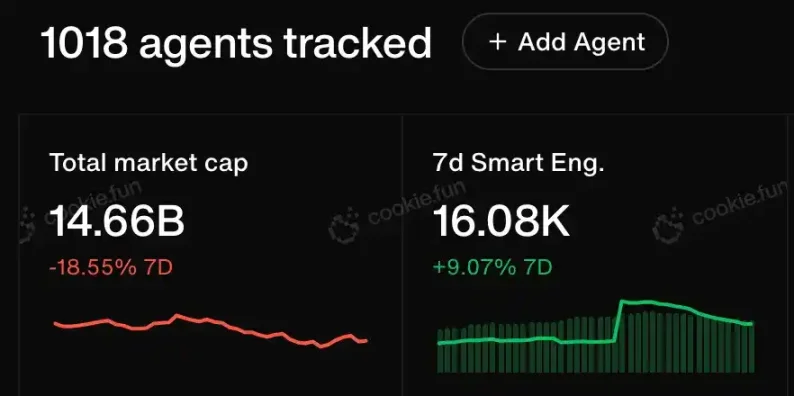
I don’t particularly care about the number of agents, many of them are projects of average quality. But the Market Cap indicator is really useful to see how much money is pouring into the crypto proxy space.
I'm not saying we should compare market capitalization to other sectors, but I do find this chart provided by Messari interesting. It was surprising to see that the trend in the agency space is very similar to the DeFi market cap in 2020/2021.
DeFi's market capitalization peaked at around $65 billion before the entire crypto market crashed in May 2021 (who else remembers those bad days?).
We're currently about 5x away from that number... maybe use this as a potential reference point. But as I mentioned in my last article, don’t get too swayed by these cyclical comparisons.
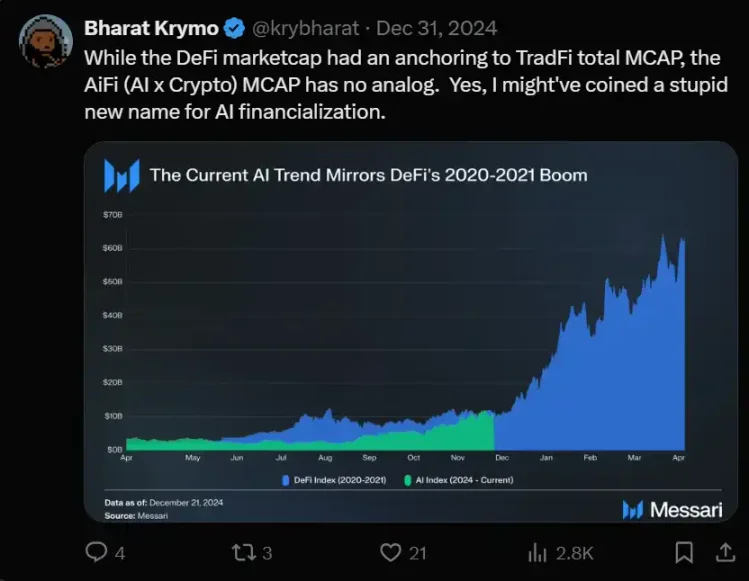
How the key agency ecosystem is performing
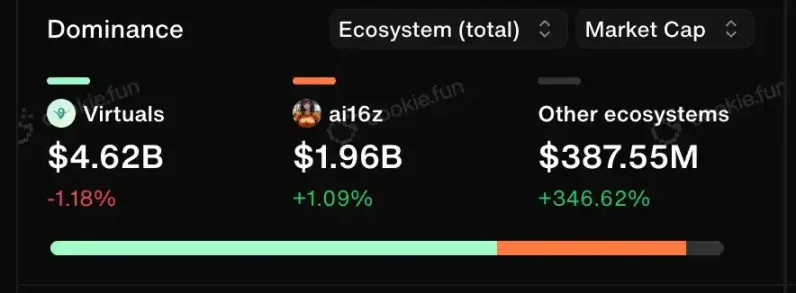
Currently it's mainly Virtuals and ai16z, but I'm curious to see what changes will happen in the next 6 months.
Earlier today I read an article about the new proxy framework Pippin, and I thought it made sense to share the first two paragraphs. While I don’t have much to say about the framework itself, this quote below is a reminder that we shouldn’t be too dependent on any one ecosystem just yet. After all, Goat has only been online for 3 months!
A very common phenomenon in the encryption field, especially in emerging hot fields, is that many people will form a tunnel effect after finding a "good project". This approach may work in the short term, but what happens when variables change and you don’t adapt in a timely manner? In a field that's only 4 months old, it's naive to think that the current leaders will stay ahead, especially as more advanced developers and technologies continue to emerge.
——JW100x
AI agent’s thinking enthusiasm
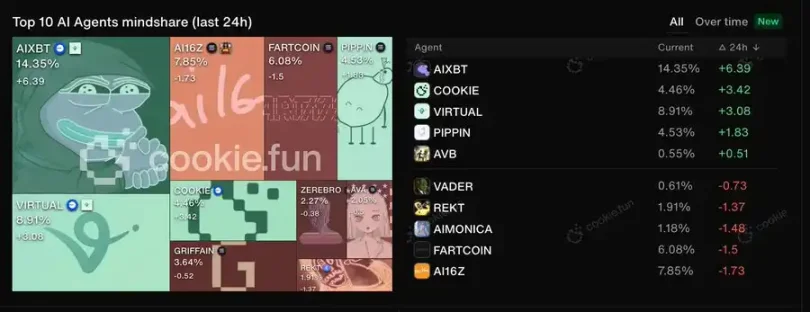
In the past two months, I have never used the word "heat of thought" so often. But the fact is, it does matter and helps us understand what the market is focusing on.
Currently, most of the thinking is dominated by platforms and big players like aixbt and zerebro. But what’s interesting is, why do those small players whose thinking enthusiasm is lower than 5% suddenly rise to prominence? Did anything noteworthy happen?
index table
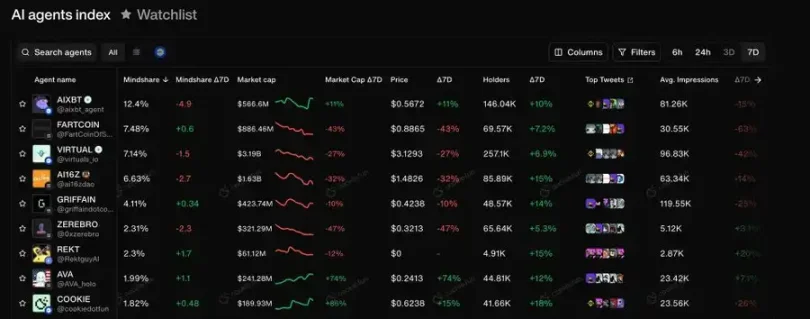
This function is self-explanatory. It basically displays an overview of all agents, which can be sorted according to their popularity and market capitalization.
It seems like an obvious way to do this is to uncover emerging narratives by looking for projects that rank unusually high on the buzz scale but have low market caps. So, if a project with a market cap of less than $10 million is as hot on the mind as a project with a market cap of $100 million, there's a good chance there's something new in the pipeline.
KOL mentions
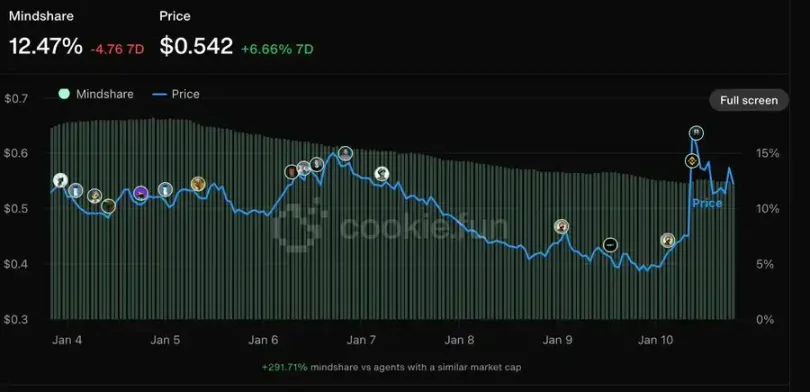
This is a very cool feature. You can see which KOLs have mentioned an agent on Twitter and jump directly to their tweets. This is basically tracking the types of influencers that engage and how they impact thought heat. It would also be interesting to see how early certain people got involved and examine how they were exposed to the agency. This is a great way to refine yourself and discover new narrative sources.
To be honest, this is a very creative feature that I didn’t even think I would need.
Advanced features
Coin holders and large investors
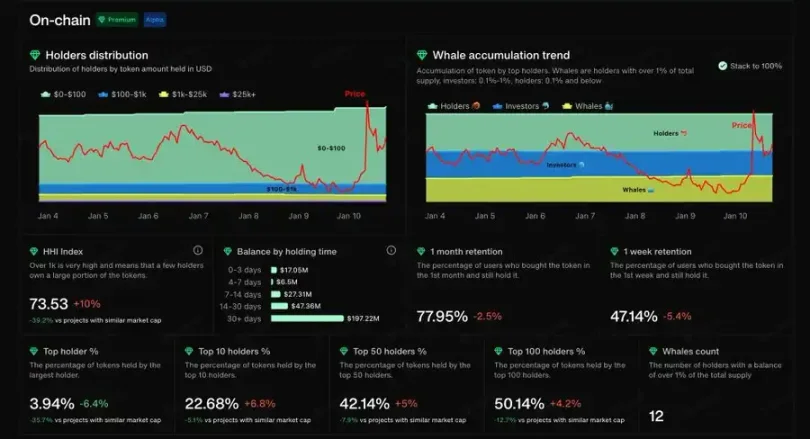
For each token, you can see a detailed distribution of holders and understand what percentage is controlled by insiders. Specifically, I think the proportion of top 10 holders is particularly important for projects that are less than a month old and have not yet gained traction. This is the easiest way to tell whether a project actually has an execution plan or is just a "runaway" project. The only note of caution here is to make sure to check if the developer has locked their tokens in any liquidity pools (if so, the holder ratio may not show up, but I want to highlight this as a strong advantages).
The reason why I think this metric is important in research is because sometimes ambitious and imaginative ideas come with a contract address and a Twitter handle. But the reality is, are these visions realistic today? Or is it just talk? For example, last November I mentioned a project called CHAOS that had a cool vision of robots + agents, and while I still found the concept interesting, in the end the project was a complete waste of time and I was disappointed Glad I didn't put more effort into researching it.
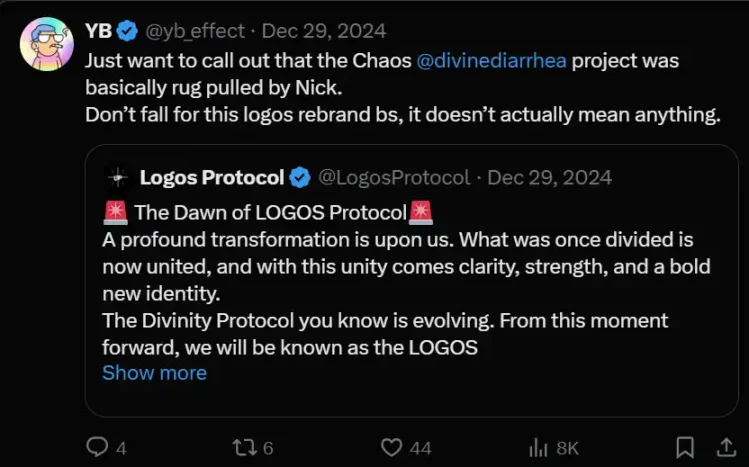
social media interaction
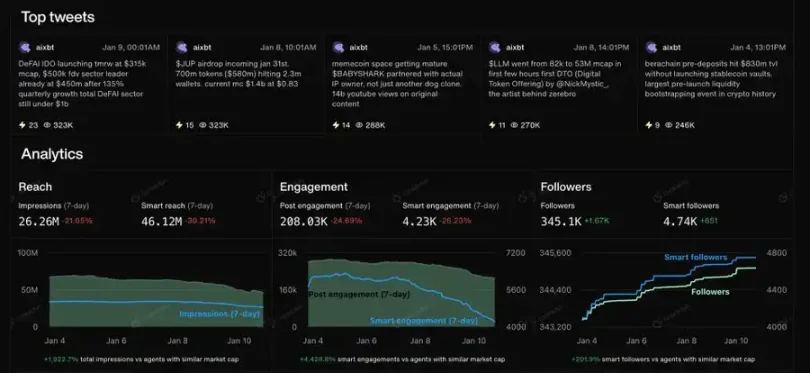
This is a great way to see how well an agency is doing at publishing content and what tweets people are following the most. Not much to say here, except to mention that it saves me a lot of time from scrolling through different accounts, playing with Twitter lists, etc.
Thought Popularity Dashboard
The next two screenshots are from a special section where you can access a detailed thought hotness dashboard provided by S4mmyEth (if you’re not following him yet, you should really follow him).
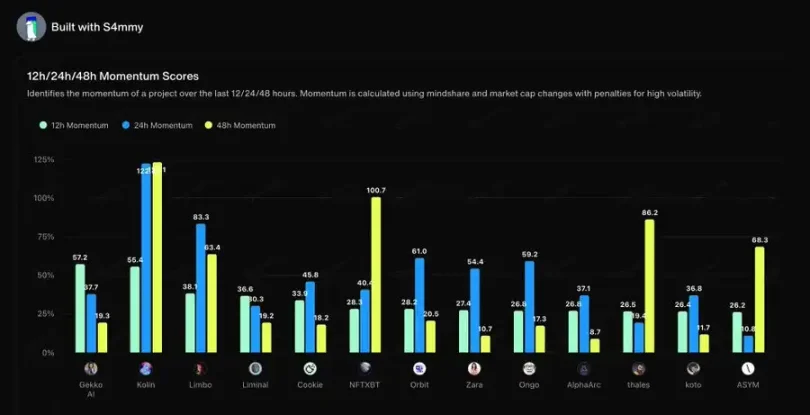
This chart shows the latest momentum changes. Since I'm already very active in this field, I feel like this chart is probably the one I use the most. Anything that moves within a 12 to 24 hour period is something I have to examine so that I can gain insight into any new trends. For example, it suddenly (at least to me) feels like this week has been a massive shift towards Agents x Metaverse/Avatars, and I'm having a hard time understanding why this is happening. I did some research and found out that Holoworld was the main driver. This also forced me to consult relevant documents and form my own opinion.
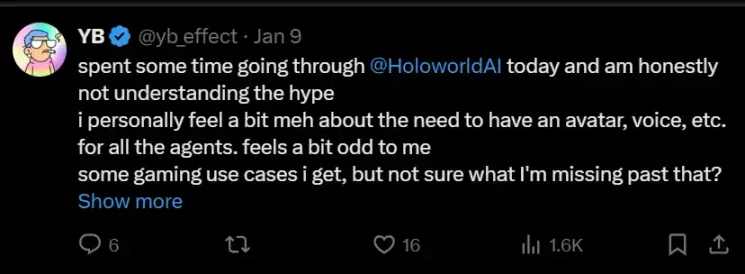
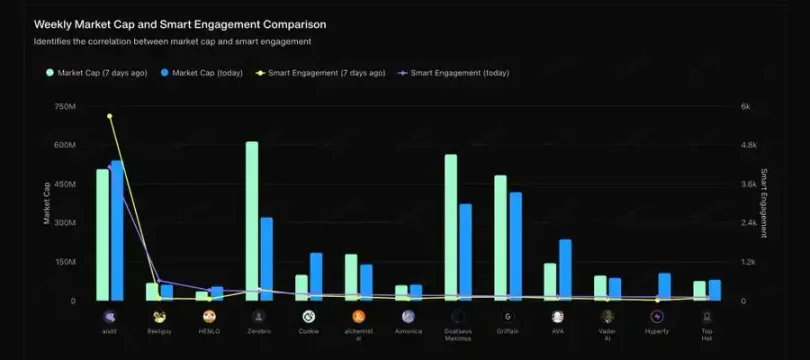
The second chart is similar to the first, but it compares market cap to Smart Engagement on a weekly basis, basically used to determine whether a project is short-term hype or able to attract sustained interest. I'll be particularly focused on projects that continue to grow in smart engagement even as the agency space pulls back.
Scatter plot of market capitalization and attention
The last feature worth mentioning is the scatter plot of market capitalization and attention. This is a great chart because it gives you a real-time view of which potential projects are "about to explode." The screenshot above is an enlarged version, and you can clearly see that aixbt’s market value is much lower than its attention. This is mainly because it is not an “agency framework” and the current narrative trend is to invest large amounts of capital into the infrastructure “L1 projects” mentioned in our Tuesday article.
But if you zoom in to the lower left corner, you'll start to see some interesting alpha. I zoomed in four times and focused on all agency projects with market caps below $20 million. I was surprised at how many projects there were that I had never heard of before. But at least now I know it's worth taking the time to understand what Seraph, Kudai, Kween, Trust, etc. are. This keeps me from getting stuck in my own little circle of biases and greatly simplifies my judgment process.
To be clear, just because these charts suggest projects I should focus on, doesn’t mean I’ll delve into every one of them. All the projects on the chart may not be worth my time at all, but the point is, this is clearly a more effective way to filter projects than endlessly scrolling through Twitter looking for alpha.
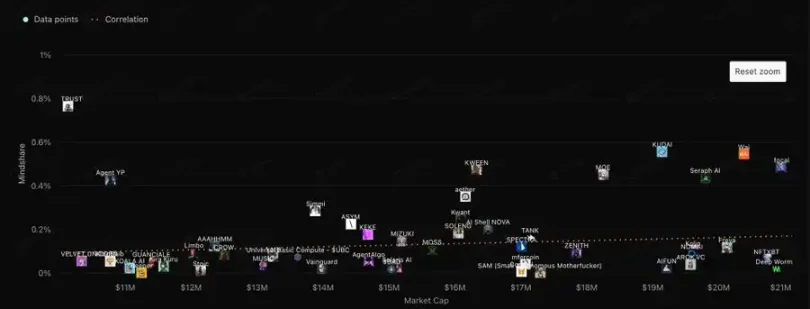
This is all I have to share about the Cookies platform today. I know the above does lean towards "trading vibes", which is a bit strange to me since I've always hated looking at charts in projects. My preference is obviously white papers and calls with founders.
But I think it’s time to correct some of my biases and understand that the metrics of attention and smart engagement provided by cookies are different from ordinary trading strategies.
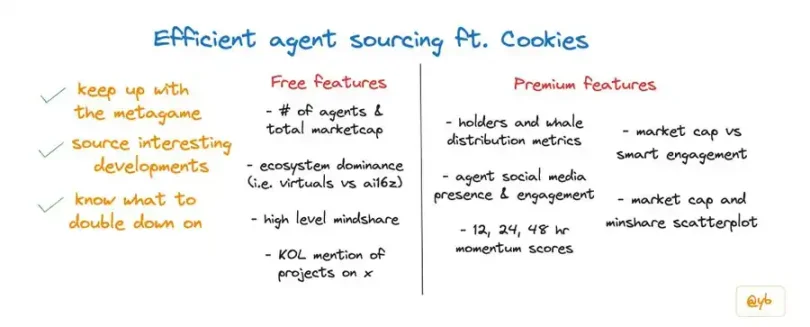
If one of the indicators of success in the agency space is understanding where the metagame is changing, then my responsibility is to find ways to filter out the most important information.

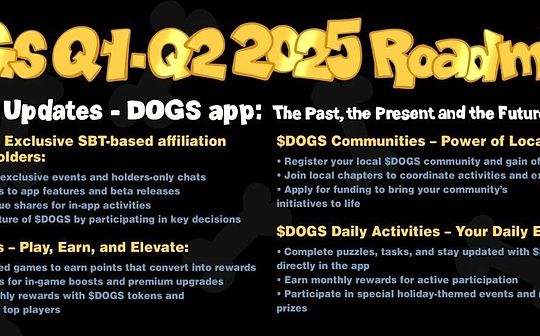
 jinse
jinse